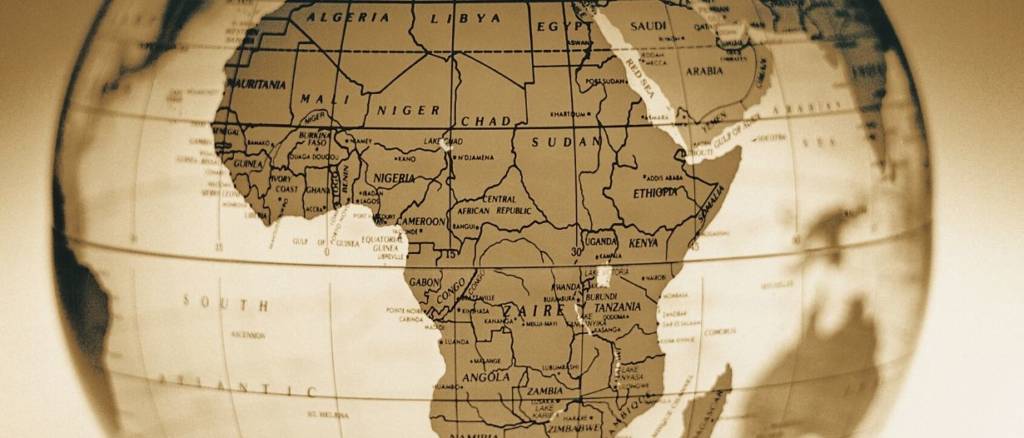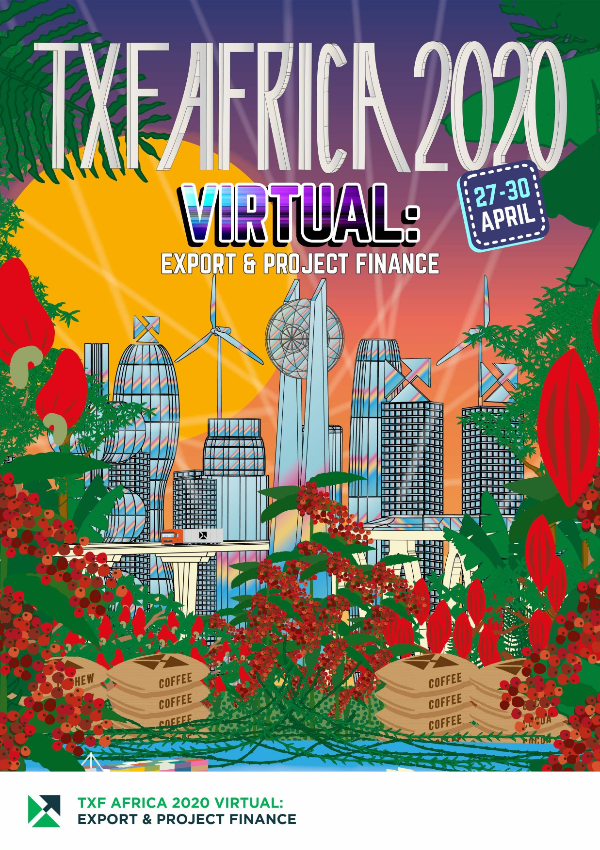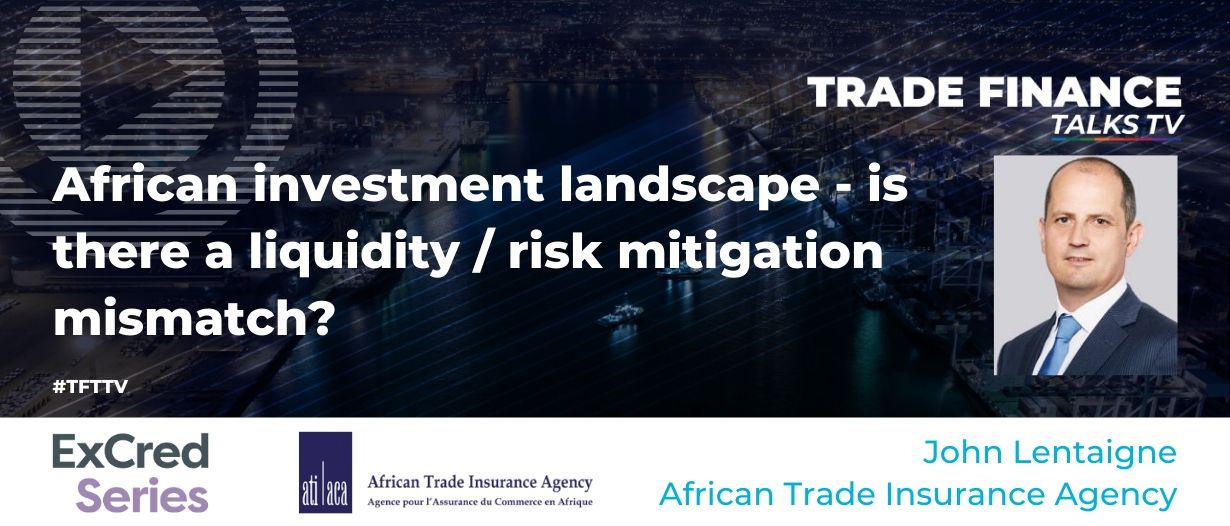TFG heard from John Lentaigne, Acting CEO at African Trade Insurance Agency, on the current investment landscape in Africa. Lentaigne spoke on corruption and transparency in Africa, addressing the capacity versus demand mismatch, and around the capacity for direct lending, as well as business support available from DFIs and MDBs in Sub Saharan Africa.
Featuring: John Lentaigne, Acting CEO, African Trade Insurance Agency
Host: Deepesh Patel, Editor, Trade Finance Global
Deepesh Patel (DP): John, thank you very much for joining us on Trade Finance Talks TV. Tell us a bit about you and ATI.
John Lentaigne (JT): Sure thanks. I’m John Lentaigne, Acting CEO, African Trade Insurance Agency (ATI), which is Africa’s Multilateral Guarantee Agency. We guarantee trade and investments across the African continent.

DP: What is causing the increasing flow of transactions in terms of longer tenor infrastructure finance?
JL: There is a huge demand and interest for investment finance in Africa. Apart from anything else, Africa has high growth rates, versus elsewhere in the world, where growth rates are fairly low.
So there’s this huge opportunity in Africa, and at ATI, we help frame these opportunities versus the ‘perceived’ risks. We are a de-risking and Development Finance Institution; one of our mandates is to lower the perception of risk and lower the cost of risk in our member states. We can do that through extending duration, and we do play a role in extending the risk profile for transactions in Africa.

DP: What are the key products that exporters can benefit out of African Trade Insurance Agency?
JT: I will answer this in relation to international exporters looking to export into Africa, but at ATI, we can also work with domestic exporters in our member states.
ATI can work as an Export Credit Agency (ECA); we don’t have the same national content requirements, and we can be more agnostic about that. As an African multilateral, we look to see whether a transaction benefits an African country, and if it does, then we can de-risk it. So we can ensure exporters against the risk of counterparty, non-payment, or country risk, for example.
Corruption and transparency in Africa
DP: Corruption and transparency is a big problem in Africa. Are governments doing enough to combat this?
JL: It’s no secret that corruption is one of the bigger challenges in a number of African countries, but not just in Africa – in emerging markets generally. Having said that, we’re seeing an increased focus by a number of countries in the sub-Saharan region to improve or to tackle corruption. Clearly, this is not something that’s going to happen overnight. But more transparency is very important.
A greater focus on the rule of law, making sure that prosecutions actually happen and go ahead. And of course, what you’ll see as countries get an emerging middle class and move to the middle-income status, people demand better governance. So I think all a number of these ingredients are present in countries across the continent, and we are seeing signs that the things are moving in the right direction.
Addressing the capacity vs. demand mismatch
DP: What avenues are available to provide enough capacity to mitigate the amount of Sub Saharan African demand, and is there appetite and capacity for lending directly to the private sector in Sub-Saharan Africa?
JL: I think the demand for de-risking in Africa exceeds the supply or the ability of de-risking institutions to cope with that demand.
ATI is one of a number of multilaterals that work on the continent and we work together. There is a co-guarantee platform that ATI has signed with other de-risking institutions in Africa to provide greater capacity – the likes of Afreximbank, African Development Bank and so on.
The other key partner for us of course, apart from export credit agencies, is private insurers. We work closely with the private investment insurers to augment capacity across African markets. But ultimately, this is a long game. We’re all working within finite risk limits. Over time, we would expect to build more capacity, as people have better experience. It’s part of our role to show that the actual fundamentals of risk perhaps aren’t as bad as the headlines might suggest.

Export finance education and raising awareness of financing opportunities
DP: Great, how are you educating people about where some of these risks don’t lie, and where the opportunities are?
JL: We do a lot of work bringing partners to the ground, into Africa. From afar, people tend to read the headlines and often, all over the world the news is dominated by the negative stories and not so much the progressive positive stories. So part of our role is to get people onto the continent and actually, see that things aren’t perhaps as tricky as they might assume. Also to broaden the appetite of investors who otherwise just couldn’t perhaps look at African risk. For example, ATI has been doing an awful lot of work with institutional investors, who by mandate historically haven’t been able to consider Sub-Saharan Africa and we’ve had a lot of success with that.
DP: Great. Moving forward for the rest of the year, where do you think the biggest opportunities lie within African Trade Insurance Agency?
JL: So as an institution, ATI now has 17 member countries as of today, we’re growing our membership very rapidly at the moment and becoming a truly pan-African institution. We were very, very busy in the kind of active, larger Sub-Saharan markets so Nigeria, Ghana, Côte d’Ivoire in West Africa, Ethiopia, Kenya, Uganda and East Africa. In the south, Zambia has a lot of opportunity again, DRC particularly with the new political environment now we’re seeing huge activity there. And again, moving to North Africa, Egypt’s recently signed up to join ATI. So we expect to do a lot of business there.
Hear more from ATI at our partner virtual conference, TXF Africa 2020

TXF Africa 2020 Virtual is a market-leading virtual event that boasts a number of networking features, exclusive data releases and high level speaker insights across three days. As one would expect from an event accessible anywhere in the world, the attendee list will not only comprise dealmakers spanning ECAs, SOEs, DFIs, MFIs, borrowers, exporters, commercial banks, law firms, insurers and governments from across the African continent but a broad swathe of those interested in investing in the region from overseas.
Editors note and update: COVID-19 and ATI Response
Speaking to John after this interview, ATI affirms its support for African business during and after the COVID-19 crisis. John said: “This is an unprecedented time for the entire world. As global financial markets continue to react to the uncertainties, it is important for long-term investors to understand that Africa, while facing similar challenges, can still offer growth opportunities. We fully expect that Africa generally, and in particular, some of the faster growing African economies, will continue to deliver myriad opportunities for investors post-Covid-19.”
ATI’s 8 risk areas are highlighted here.
DP: John, it’s been a pleasure having you on Trade Finance Talks TV. Thank you for coming on the show.




























